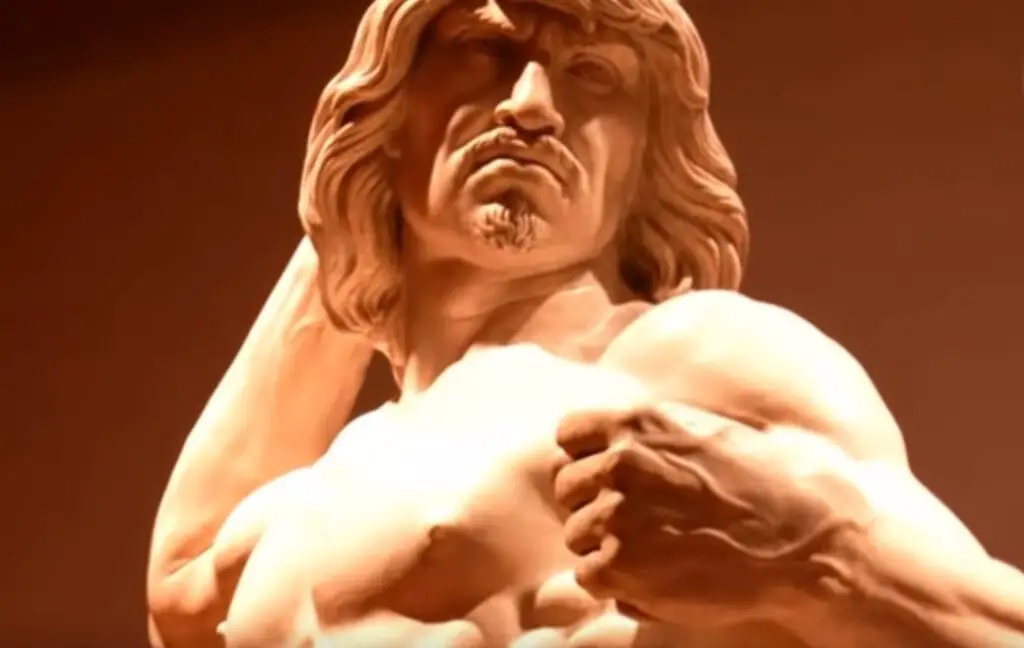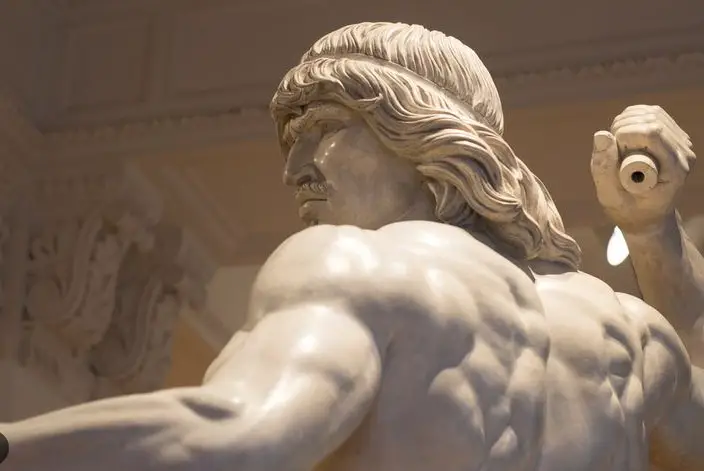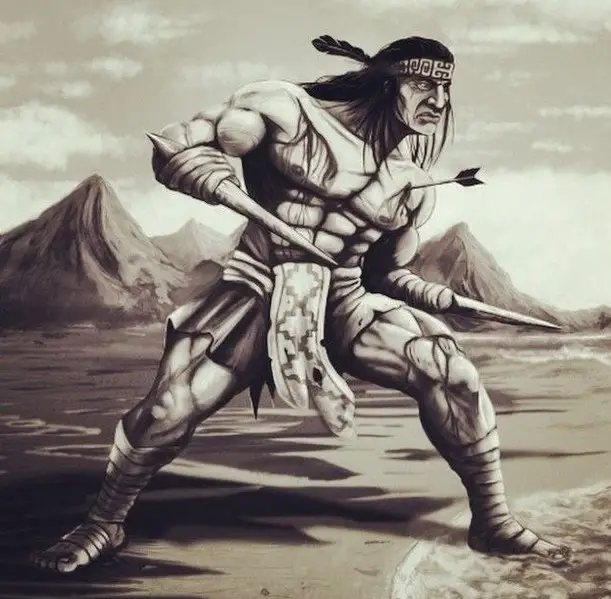Podcast: Play in new window | Download
Subscribe: Apple Podcasts | RSS
 The year was 1852, and the place was an art studio in Mexico City. Catalonian sculptor Manuel Vilar i Roca was putting the finishing touches on a special metal sculpture. Vilar’s magnificent art piece depicted Tlahuicole, a Tlaxcalan warrior whose exploits were still being talked about decades after the Spanish Conquest. Vilar was born in Spain but learned to sculpt in Rome. As a young man he studied with the Italian masters at the time, Antoni Solá and Pietro Tenerani, as well as with Bertel Thorvaldsen, a famous sculptor from Iceland living in Italy while Vilar was there. Vilar’s artistic style has been described as a combination of Romanticism and Realism. He took on Biblical and mythological themes including such subjects as Daniel in Babylon and Jason with the Golden Fleece. In 1845, Vilar left Europe and accepted a job overseeing the sculpture classes at the Academia de San Carlos in Mexico City. Located just north of Mexico City’s main plaza, the academia is the oldest art school in the Western Hemisphere. While teaching sculpting to promising Mexican artists, Vilar became interested in Mexican subjects for his own art projects. Employing his blended style of Romanticism and Realism, Vilar created beautiful classical sculptures of notable Mexicans spanning the country’s long history, including Aztec Emperor Montezuma the Second; the Malinche; the first emperor of the independent country of Mexico, Agustín Iturbide; General Antonio Lopez de Santa Ana; and his famous 1852 bronze statue of the native hero known to history as Tlahuicole. Vilar was part of a greater artistic movement in Mexico at the time that sought to dig deep into the country’s indigenous past for artistic inspiration and to help Mexico forge a new identity by blending pre- and post-Conquest themes. Mexican president at the time, Mariano Arista, was pleased with the statue and sent the sculptor his best wishes for future projects that would glorify Mexico’s past. The dramatic sculpture of the Tlaxcalan warrior stands proudly today in one of the main streets of Tlaxacala City, where Tlahuicole’s name was once uttered on the lips of every citizen some five centuries ago.
The year was 1852, and the place was an art studio in Mexico City. Catalonian sculptor Manuel Vilar i Roca was putting the finishing touches on a special metal sculpture. Vilar’s magnificent art piece depicted Tlahuicole, a Tlaxcalan warrior whose exploits were still being talked about decades after the Spanish Conquest. Vilar was born in Spain but learned to sculpt in Rome. As a young man he studied with the Italian masters at the time, Antoni Solá and Pietro Tenerani, as well as with Bertel Thorvaldsen, a famous sculptor from Iceland living in Italy while Vilar was there. Vilar’s artistic style has been described as a combination of Romanticism and Realism. He took on Biblical and mythological themes including such subjects as Daniel in Babylon and Jason with the Golden Fleece. In 1845, Vilar left Europe and accepted a job overseeing the sculpture classes at the Academia de San Carlos in Mexico City. Located just north of Mexico City’s main plaza, the academia is the oldest art school in the Western Hemisphere. While teaching sculpting to promising Mexican artists, Vilar became interested in Mexican subjects for his own art projects. Employing his blended style of Romanticism and Realism, Vilar created beautiful classical sculptures of notable Mexicans spanning the country’s long history, including Aztec Emperor Montezuma the Second; the Malinche; the first emperor of the independent country of Mexico, Agustín Iturbide; General Antonio Lopez de Santa Ana; and his famous 1852 bronze statue of the native hero known to history as Tlahuicole. Vilar was part of a greater artistic movement in Mexico at the time that sought to dig deep into the country’s indigenous past for artistic inspiration and to help Mexico forge a new identity by blending pre- and post-Conquest themes. Mexican president at the time, Mariano Arista, was pleased with the statue and sent the sculptor his best wishes for future projects that would glorify Mexico’s past. The dramatic sculpture of the Tlaxcalan warrior stands proudly today in one of the main streets of Tlaxacala City, where Tlahuicole’s name was once uttered on the lips of every citizen some five centuries ago.
It has been difficult for historians to untangle the myth from the reality of the life of Tlahuicole, who has been described as “The Mexican Hercules.” Born in the Republic of Tlaxcala, Tlahuicole lived from 1497 to 1518. He died at the age of 21 just one year before Cortés and his band of conquistadors arrived at the Aztec capital of Tenochtitlán. So, in the early days of the Spanish Conquest of Mexico, there were many people alive who had known the warrior or even fought alongside him. The Spanish, who liked to write down as much as they could, compiled stories of Tlahuicole, and this is where we get most of our information from.
 To understand Tlahuicole the warrior, we must first endeavor to understand Tlahuicole’s world. He was born into a climate of resistance and struggle, in Tlaxcala, a small independent state completely surrounded by the Aztec Empire. The Tlaxcalan state was able to survive for so long because the Aztecs used the Tlaxcalans to give their warriors fighting experience in what was termed the Flower Wars. These wars wore down the Tlaxcalans, but it was to the Aztec’s advantage to keep Tlaxcala independent to ensure a steady stream of captives and for the experience for their warriors as already mentioned. For more details about the Republic of Tlaxcala and the Flower Wars, please see Mexico Unexplained Episode 327: https://mexicounexplained.com/the-ancient-republic-of-tlaxcala/ When Tlahuicole was born, Emperor Ahuizotl ruled over the greatest extent that the Aztec Empire had ever known. Ahuizotl was an aggressive and expansionistic emperor and fought multiple wars on multiple fronts. During the reign of Ahuizotl, the small landlocked Republic of Tlaxcala felt the squeeze and fought constant wars with their larger, more resource-hungry neighbor. For more information on Ahuizotl, please see Mexico Unexplained Episode 344: https://mexicounexplained.com/emperor-ahuizotl-and-the-expansion-of-the-aztec-empire/
To understand Tlahuicole the warrior, we must first endeavor to understand Tlahuicole’s world. He was born into a climate of resistance and struggle, in Tlaxcala, a small independent state completely surrounded by the Aztec Empire. The Tlaxcalan state was able to survive for so long because the Aztecs used the Tlaxcalans to give their warriors fighting experience in what was termed the Flower Wars. These wars wore down the Tlaxcalans, but it was to the Aztec’s advantage to keep Tlaxcala independent to ensure a steady stream of captives and for the experience for their warriors as already mentioned. For more details about the Republic of Tlaxcala and the Flower Wars, please see Mexico Unexplained Episode 327: https://mexicounexplained.com/the-ancient-republic-of-tlaxcala/ When Tlahuicole was born, Emperor Ahuizotl ruled over the greatest extent that the Aztec Empire had ever known. Ahuizotl was an aggressive and expansionistic emperor and fought multiple wars on multiple fronts. During the reign of Ahuizotl, the small landlocked Republic of Tlaxcala felt the squeeze and fought constant wars with their larger, more resource-hungry neighbor. For more information on Ahuizotl, please see Mexico Unexplained Episode 344: https://mexicounexplained.com/emperor-ahuizotl-and-the-expansion-of-the-aztec-empire/
From the time he was a boy, Tlahuicole knew he would be a warrior. As a young teenager, he was already proving himself in battle. People who knew him during this time described him as being not too tall but broad-shouldered and muscular. He was an expert with the bow and arrow and the war club and excelled in all forms of hand-to-hand combat. By his late teens, Tlahuicole became  known throughout ancient Mexico for his bravery and his honorable character. The hundreds of thousands of conquered people living under Aztec domination saw Tlahuicole as a folk hero and later accounts of his exploits indicated that the Tlaxcalan warrior gave hope to those people who were reluctant subjects of the Aztec Empire. At the age of 19 Tlahuicole commanded the Tlaxcalan forces that participated in a civil war in the Kingdom of Texcoco. When the king of Texcoco died in the year 1516, several of the king’s sons vied for the throne. The Kingdom of Texcoco was part of the Aztec Empire but was still allowed to keep its own nobility and certain laws and customs. Tlaxcala had many interests in who would rule Texcoco, so that is why they sent in troops headed by Tlahuicole to back the successor who had their best interests at heart. While Tlahuicole acted valiantly in battle, he was ultimately captured by the Aztecs. One account claims that he was captured while hiding in a swamp. Other stories say that he was subdued on the battlefield. In any case, he was put into a wooden cage and transported to the Aztec capital. Hundreds of people lined the causeways and broad avenues of Tenochtitlán to see this famous warrior in the cage. History does not record whether there were boos or cheers along the way, but there most certainly must have been curiosity and sneaking admiration felt among the throngs of people witnessing the procession. Tlahuicole was taken directly to the imperial palace. These were the direct orders of Emperor Montezuma the Second who wanted to see this mythic warrior of legendary proportions face to face.
known throughout ancient Mexico for his bravery and his honorable character. The hundreds of thousands of conquered people living under Aztec domination saw Tlahuicole as a folk hero and later accounts of his exploits indicated that the Tlaxcalan warrior gave hope to those people who were reluctant subjects of the Aztec Empire. At the age of 19 Tlahuicole commanded the Tlaxcalan forces that participated in a civil war in the Kingdom of Texcoco. When the king of Texcoco died in the year 1516, several of the king’s sons vied for the throne. The Kingdom of Texcoco was part of the Aztec Empire but was still allowed to keep its own nobility and certain laws and customs. Tlaxcala had many interests in who would rule Texcoco, so that is why they sent in troops headed by Tlahuicole to back the successor who had their best interests at heart. While Tlahuicole acted valiantly in battle, he was ultimately captured by the Aztecs. One account claims that he was captured while hiding in a swamp. Other stories say that he was subdued on the battlefield. In any case, he was put into a wooden cage and transported to the Aztec capital. Hundreds of people lined the causeways and broad avenues of Tenochtitlán to see this famous warrior in the cage. History does not record whether there were boos or cheers along the way, but there most certainly must have been curiosity and sneaking admiration felt among the throngs of people witnessing the procession. Tlahuicole was taken directly to the imperial palace. These were the direct orders of Emperor Montezuma the Second who wanted to see this mythic warrior of legendary proportions face to face.
Tlahuicole’s reputation preceded him, of course, and Montezuma was faced with the dilemma of what to do with this famous person who was a huge thorn in the side of the Empire. History records that the Aztec emperor allowed the Tlaxcalan warrior the privilege of seeing his face and Tlahuicole remarked that it was an honor to do so, being polite and deferential to the ruler. Expecting to be executed for being an enemy combatant, Tlahuicole was surprised when Montezuma showed mercy and decided to spare his life. According to historians, this was unprecedented in Aztec history. When Montezuma told him of his pardon, Tlahuicole asked that his life NOT be spared and that the emperor give him a noble death fitting of a warrior. However, according to the historical accounts, Montezuma was so impressed by Tlahuicole’s demeanor that he offered him a position in his own military. One could only imagine that this was pure political strategy. Montezuma was most likely trying to co-opt and therefore own the mythical warrior that was a threat to the social and political stability of his empire. The emperor told Tlahuicole that he would be participating in a bloody campaign against the Tarascans to the west, and he would have an opportunity to die a glorious warrior’s death in the battlefield during this campaign. Since Tlahuicole did not have much of a choice, he agreed to take part in this Tarascan campaign. Montezuma did not expect to see him again.
Eager for battle, Tlahuicole led Aztec troops in the Seige of Tangimoroa, a Tarascan city known to the Aztecs as Tlaximaloyan, which is now known as Ciudad Hidalgo in the Mexican state of Michoacán. The Aztecs took the city and Tlahuicole led the Aztecs to victory in many battles surrounding Tangimoroa. The Tarascans, suffering massive casualties, retreated. Ultimately, Tlahuicole returned to Tenochtitlán leading the triumphant troops. Montezuma looked out at the celebrations from the shadows of the imperial palace. The emperor now had a bigger problem on his hands.
 What was the Aztec emperor to do? The troublesome Tlaxcalan warrior did not die in battle as expected. What happened to Tlahuicole after his return to Tenochtitlán is up to debate among scholars. There are two conflicting stories. One story alleges that Emperor Montezuma lavished Tlahuicole with gifts, including fancy clothes and anything else he desired, but he was under a sort of house arrest in the Aztec imperial palace and was not allowed to return home to Tlaxcala. In this story, Tlahuicole was like a bird in a gilded cage and despite the fineries he missed his wives and children too much. He cried day and night until one day he could not bear the misery and killed himself. Another story tells of how Emperor Montezuma was determined to kill the warrior but made a spectacle of it for an elite audience. In this version of Tlahuicole’s demise, the warrior was tasked with fighting 9 men in gladiatorial combat, using various weapons of war and hand-to-hand combat. Tlahuicole killed the first 8 who fought him but succumbed to the 9th fighter who killed him with a blow to the head. Historians have interesting theories as to why multiple stories exist regarding Tlahuicole’s death. The first story of the warrior pining away in the lap of luxury of the palace and then killing himself, historians believe, is the official story put out by Montezuma. This story was created as propaganda to soil the name and memory of Tlahuicole and to ensure that his disgraceful death would overshadow his larger-than-life mythos as a folk hero and giver of hope to the thousands of the dispossessed who looked up to him throughout the Aztec Empire and beyond. Most likely, the gladiator spectacle was how the Tlaxalan warrior really died, and the true story got out the way news often does, when witnesses of the event began to talk, and the real account of the events spread. The Spanish later recorded that back home in Tlaxcala most people did not buy the suicide and believed that Tlahuicole died bravely in gladiator combat. This goes to show that even 500 years ago propaganda had a hard time overpowering truth.
What was the Aztec emperor to do? The troublesome Tlaxcalan warrior did not die in battle as expected. What happened to Tlahuicole after his return to Tenochtitlán is up to debate among scholars. There are two conflicting stories. One story alleges that Emperor Montezuma lavished Tlahuicole with gifts, including fancy clothes and anything else he desired, but he was under a sort of house arrest in the Aztec imperial palace and was not allowed to return home to Tlaxcala. In this story, Tlahuicole was like a bird in a gilded cage and despite the fineries he missed his wives and children too much. He cried day and night until one day he could not bear the misery and killed himself. Another story tells of how Emperor Montezuma was determined to kill the warrior but made a spectacle of it for an elite audience. In this version of Tlahuicole’s demise, the warrior was tasked with fighting 9 men in gladiatorial combat, using various weapons of war and hand-to-hand combat. Tlahuicole killed the first 8 who fought him but succumbed to the 9th fighter who killed him with a blow to the head. Historians have interesting theories as to why multiple stories exist regarding Tlahuicole’s death. The first story of the warrior pining away in the lap of luxury of the palace and then killing himself, historians believe, is the official story put out by Montezuma. This story was created as propaganda to soil the name and memory of Tlahuicole and to ensure that his disgraceful death would overshadow his larger-than-life mythos as a folk hero and giver of hope to the thousands of the dispossessed who looked up to him throughout the Aztec Empire and beyond. Most likely, the gladiator spectacle was how the Tlaxalan warrior really died, and the true story got out the way news often does, when witnesses of the event began to talk, and the real account of the events spread. The Spanish later recorded that back home in Tlaxcala most people did not buy the suicide and believed that Tlahuicole died bravely in gladiator combat. This goes to show that even 500 years ago propaganda had a hard time overpowering truth.
REFERENCES
Cordero, Anthony. Tlahuicole, El Indomable. Self-Published, 2022. We are Amazon affiliates. Buy the book on Amazon here: https://amzn.to/478HRH4
